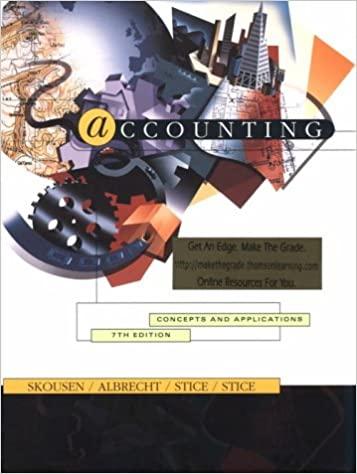Question
1 An amortized premium is computed annually when a bond is issued for other than its face value. For a bond issued at a premium,
1 An amortized premium is computed annually when a bond is issued for other than its face value. For a bond issued at a premium, how will this component change under the effective interest method as the bond approaches maturity?
a.Remain constant
b.Decrease
c.Increase
d.Not enough information given to decide
2 The cash interest payment is computed annually when a bond is issued for other than its face value. For a bond issued at a discount, how will this component change as the bond approaches maturity?
a.Remain constant
b.Decrease
c.Increase
d.Not enough information given to decide
3 Carrying value is computed annually when a bond is issued for other than its face value. For a bond issued at a premium, how will this component change as the bond approaches maturity?
a.Increase
b.Remain constant
c.Decrease
d.Not enough information given to decide
4 Which of the following items should not appear in the Long-Term Liability section of the balance sheet?
a.Accrued income taxes
b.Bonds payable
c.Capital lease with a ten-year term
d.Pension obligations
5 All of the following refer to the face rate of interest on a bond except
a.effective rate.
b.stated rate.
c.nominal rate.
d.coupon rate.
6 Which of the following is true regarding the statement of cash flows?
a.The repurchase of stock from stockholders is an investing activity.
b.The payment of cash dividends is a financing activity.
c.The declaration of stock dividends is a financing activity.
d.The sale of stock to stockholders is an investing activity.
7 Which of the following is reported as a financing activity on the statement of cash flows?
a.Declaration of dividends
b.Conversion of preferred stock to common stock
c.Stock split
d.Sale of preferred stock
8 All of the following are reasons for a company to repurchase its previously issued stock, except
a.to increase the shares outstanding.
b.for bonuses to employees.
c.to resell to employees.
d.to support the market price of the stock
9 If a company has both common and preferred shares outstanding and wishes to calculate book value per share,
a.net assets, less the redemption value of the preferred stock, must be divided by the number of shares of common stock outstanding.
b.stockholders' equity must be divided by the total number of both classes of stock.
c.stockholders' equity, less the cost of treasury shares held, must be divided by the number of common shares outstanding.
d.net assets must be divided by the total number of both classes of stock.
Step by Step Solution
There are 3 Steps involved in it
Step: 1

Get Instant Access to Expert-Tailored Solutions
See step-by-step solutions with expert insights and AI powered tools for academic success
Step: 2

Step: 3

Ace Your Homework with AI
Get the answers you need in no time with our AI-driven, step-by-step assistance
Get Started


